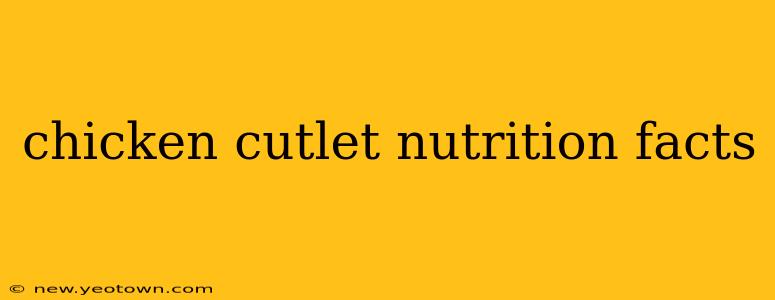Chicken cutlets – thin, breaded, and pan-fried slices of chicken breast – are a staple in many cuisines. But what exactly makes up this culinary favorite? Let's delve into the nutritional details of chicken cutlets, exploring their pros, cons, and how to make them a healthier part of your diet. Our journey begins with a simple question: what are the basic nutritional facts of a chicken cutlet?
What are the basic nutritional facts of a chicken cutlet?
The nutritional information for a chicken cutlet varies significantly depending on its size, preparation method (breading type and oil used), and any added ingredients. A typical 3-ounce (85g) unbreaded, pan-fried chicken cutlet contains roughly:
- Calories: 150-200
- Protein: 25-30 grams
- Fat: 5-10 grams
- Carbohydrates: 1-2 grams
However, this drastically changes once breading enters the equation. Breading adds significant carbohydrates and fat, often doubling or tripling the calorie count and boosting the fat and carbohydrate content substantially. A breaded chicken cutlet can easily contain 300-400 calories or more.
How many calories are in a chicken cutlet?
As mentioned earlier, the calorie count hinges heavily on preparation. A plain, unbreaded chicken cutlet is relatively low in calories. But the addition of bread crumbs, often combined with deep frying or excessive oil, significantly increases the calorie content. Therefore, there isn't a single definitive answer; it's crucial to consider the preparation method.
Are chicken cutlets healthy?
The healthfulness of a chicken cutlet depends entirely on how it's prepared. A lean, unbreaded cutlet cooked with minimal oil is an excellent source of protein and relatively low in fat and calories, making it a healthy choice. However, heavily breaded and deep-fried versions can become quite unhealthy due to the added fat and calories from the breading and cooking method.
What are the benefits of eating chicken cutlets?
When prepared healthily, chicken cutlets offer numerous benefits:
- Excellent source of protein: Chicken breast is a lean protein source, essential for muscle building, repair, and overall bodily functions.
- Good source of essential nutrients: Chicken provides vitamins like niacin and selenium, alongside minerals like phosphorus and potassium.
- Versatile and convenient: Chicken cutlets are incredibly versatile, easily adaptable to various cuisines and dietary needs.
What are the drawbacks of eating chicken cutlets?
The drawbacks primarily stem from unhealthy preparation methods:
- High in calories and fat: Heavily breaded and fried cutlets contribute significantly to daily calorie and fat intake, potentially leading to weight gain.
- High in sodium: Many breading mixes and marinades contain high levels of sodium, which can contribute to hypertension.
- Potential for unhealthy fats: Deep frying with unhealthy oils can increase trans fat intake, negatively impacting cardiovascular health.
How can I make healthier chicken cutlets?
Making healthier chicken cutlets is entirely possible with a few simple adjustments:
- Choose lean chicken breast: Ensure you are starting with lean chicken breast for a lower fat content.
- Minimize breading: Use a light, whole-wheat breadcrumb coating, or try alternatives like crushed almonds or oats.
- Bake or pan-fry with minimal oil: Baking or pan-frying with a minimal amount of cooking spray or olive oil significantly reduces the fat content.
- Control portion sizes: Be mindful of portion size to manage calorie intake.
By focusing on these adjustments, you can enjoy the delicious taste of chicken cutlets while significantly reducing their negative impact on your health. Remember, informed choices in preparation are key to making this dish a healthy addition to your diet.

